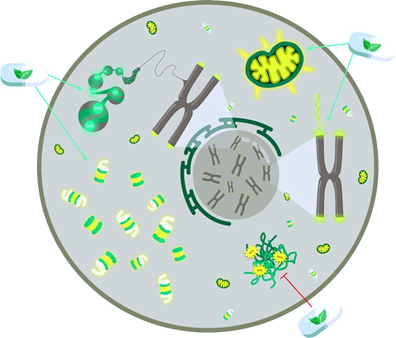

Aging and longevity are two multifactorial biological phenomena whose knowledge at molecular level is still limited. We have studied proteasome function in replicative senescence and cell survival (Mol Aspects Med 35, 1-71; Ageing Res Rev 23, 37-55). We have observed reduced levels of proteasome content and activities in senescent cells due to the down-regulation of the catalytic subunits of the 20S complex (J Biol Chem 278, 28026-28037). In support, partial inhibition of proteasomes in young cells by specific inhibitors induces premature senescence which is p53 dependent (Aging Cell 7, 717-732). Stable over-expression of catalytic subunits or POMP resulted in enhanced proteasome assembly and activities and increased cell survival following treatments with various oxidants. Importantly, the developed “proteasome activated” human fibroblasts cell lines exhibit a significant delay of senescence (J Biol Chem 280, 11840-11850; J Biol Chem 284, 30076-30086). Similar proteasome activation in human mesenchymal stem cells not only increases their lifespan, but also enhances stemness mediated by Oct4 (Free Rad Biol Med 103, 226-235). Moreover, additional findings indicate that the recorded proteasome activation is mediated by the transcription factors Nrf2 (J Biol Chem 285, 8171-8184) and FoxO1 (Front Cell Dev Biol 9, 625715). Finally, we provide evidence that proteasome activation is an evolutionary conserved mechanism, as it can delay aging in vivo and, importantly, it also confers deceleration of aggregation-related pathologies, such as Alzheimer’s or Huntington’s diseases (FASEB J 29, 611-622). Given these findings, recent work has identified a set of proteasome activators that decelerate aging and Alzheimer’s disease progression in various in vivo models (Antiox Redox Signal 25, 855-869; Free Rad Biol Med 162, 88–103).
We have also developed biobanks of donors of different ages, including healthy centenarians and long-lived siblings. Using these biobanks we have cloned several novel longevity genes (Biogerontology 5, 401-409) and we have found that healthy centenarians have a functional proteasome (Exp Gerontol 35, 721-728). Moreover, we have identified specific somatic point mutations in mtDNA control region (PLoS One 5, e13395; Aging Cell 13, 101-107) and four chromosomal loci (Aging Cell 12, 184-193) that are linked with healthy aging and longevity. Finally, we determine the rate of aging and the efficacy of anti-aging protocols based mainly on the use of natural compounds by analysing various molecular biomarkers in PBMCs of healthy individuals. To this end we measure the levels of several established biomarkers of aging (telomeres length & telomerase activity, proteasome content and function, NAD levels, global DNA methylation, Clu/ApoJ expression, AGE levels, levels of oxidized proteins) in volunteers every 3-6 months. This work leads to the development of personalized anti-aging protocols and innovative wellness products (Antioxidants 2022, 11(3), 468, patent no 246-0004480602).
Biological Age Measurement
Advancing age is a major risk factor for all chronic diseases, including neurodegeneration and cardiovascular disease and, since average human life expectancy is still increasing, the social and economic consequences of diseases associated with aging pose significant concerns. Alternatively, an emerging strategy for the treatment of chronic age-related diseases is the pharmacological targeting of the underlying aging process. In this context, we will exploit biomarkers that serve as a measure of “biological” age and predict the future onset of age-related diseases (including neurodegenerative diseases) and/or residual lifetime more accurately than chronological age. The determination of biological age is directly applicable to healthy middle-aged individuals, giving an indicator of the future course of health over the next two decades or more. The predictive ability of aging biomarkers opens the possibility of personalized long-term treatment to prevent some of the most devastating of age-related diseases and to secure wellness. Therapies and lifestyle interventions that control "biological age", in order to slow down the manifestation of the aging phenotype, represent a whole new approach for promoting human health and reducing the risk of chronic and costly late-onset diseases.
To this end, levels of established biomarkers of aging (telomeres length and oxidized protein levels) are measured in isolated PBMCs and serum. Each biomarker identifies the risk of specific diseases and provides information for possible personalized interventions across entire age groups.
1. Telomere length
In humans, telomeres are heterochromatic structures with tandem DNA repeats of 5′-TTAGGG-3′ at the chromosomal ends. Telomere length varies greatly among species and ranges from 5 to 15 kb in humans. With each cell division, telomeres shorten progressively because of the ‘end-replication problem’. Short or dysfunctional telomeres are often recognized as DNA DSBs, triggering cell-cycle arrest and result in cellular senescence or apoptotic cell death. Therefore, telomeres are considered the “biological clock” of the cell, a discovery that was awarded the Nobel Prize in 2009. Telomerase is the enzyme responsible for the maintenance of telomere length. The telomere length and the telomerase activity are important biomarkers for determining the biological age of the cells. Τelomere shortening has been discovered to be one of the primary causes of human ageing. Short telomeres have been associated with almost all chronic diseases related to ageing such as cancer, heart disease, diabetes and autoimmune diseases. Normal cells undergo a senescence arrest when faced with a variety of potentially oncogenic damage or stimuli. These include dysfunctional telomeres, certain types and levels of DNA damage, perturbations in chromatin, and the expression of certain oncogenes such as mutant RAS. Comprehensive, lifestyle interventions, nutrition, correction of nutritional deficiencies, proper exercise and administration of natural substances that trigger innate cellular repair mechanisms may promote telomere maintenance in human immune-system cells.
Determination method: RT-PCR
Biological material: 6-8ml of blood
2. Oxidized Proteins’ Levels
Ageing is associated with increased oxidative damage in proteins. Oxidative damage accumulation in macromolecules has been considered causative for cellular damage and pathology. Such damage seems to be closely related to the ageing process. Accumulation of oxidized proteins is a clinically important prognostic factor in age-related diseases such as cardiovascular disease and Alzheimer's disease (recommended in patients with a history of cardiovascular disease), while dietary antioxidants are capable of extending the lifespan of model organisms and alleviate the pathology of age-related diseases. Levels of oxidized proteins are measured in plasma with sandwich ELISA that detects the carbonylated groups on proteins.
Determination method: ELISA
Biological material: 4-5ml of blood
The laboratory of “Molecular and Cellular Ageing” already holds a series of natural and synthetic anti-aging compounds that maintain telomere integrity and exhibit antioxidant properties.
- Regulation of pluripotency and self-renewal of adult stem cells by the Ubiquitin Proteasome System (UPStem)
Stem cell (SC) exhaustion is a fundamental hallmark of aging, and is causal in an ever-growing number of late-onset diseases. Our previous work revealed that senescent human mesenchymal SCs (hMSCs) exhibit decreased proteasome content and function, while genetic activation of the proteasome can enhance their stemness and lifespan. Based on these data, we postulate that the enhancement of proteasome activity may modulate the abundance of specific substrates to protect SCs from senescence and promote the pluripotent state. The specificity of the UPS-mediated protein degradation is provided by the E3 ligase complex, which conjugates activated ubiquitin to a target substrate to tag it for degradation by the proteasome. Setting out to define UPS-regulated pluripotency and senescence factors, we will map the global changes in the ubiquitinated protein landscape of young pluripotent and senescent hMSCs using shotgun proteomics. Moreover, we will reveal novel E3 ligases that regulate the abundance of the identified substrates and are essential for the regulation of hMSC pluripotency, homeostasis and senescence. Given the reversible nature of ubiquitin tagging, in conjunction with the availability of proteasome activators as well as of specific antagonists of ligase function, this study is expected to highlight exciting new avenues for SC-based regenerative interventions.
- Identification Greek Flora derived dietary compounds with anti-aging properties
Our studies have established the antioxidant and antiaging effects of naturally derived compounds, with an emphasis on Greek flora, in various cell types and model organisms. For instance, flavonoids and polyphenols have attracted growing interest for their potent lifespan-extending, anti-aggregation and antioxidant properties in cell cultures and model organisms. Different antiaging and antioxidant mechanisms act in a complex interplay that results in significant improvements in various hallmarks of aging in cellulo and in vivo. Our observations are setting the ground for further studies to identify the long-term implications of such changes and focus on the underlying mechanisms of complementary action in antioxidant compound mixtures. Understanding the molecular processes of age-related health decline is of paramount importance for the study of aging pace, both as a target and as an outcome. Therefore, proper investigation of the effects of such nutraceutical combinations on aging biomarkers in the context of large interventional and longitudinal studies will further expand the arsenal of therapeutic strategies to delay aging and protect against age-onset pathologies.
- Analysis of biobank samples to identify new pathways involved in human aging
The major aim of this project is to exploit biobanks established from our laboratory in order to identify connections between hallmarks of aging in humans. To this end, miRNA-seq analyses are currently in progress, in collaboration with Professor Artemis Hatzigeorgiou, Bioinformatics Laboratory, HPI.
- Regulation of pluripotency and self-renewal of adult stem cells by the Ubiquitin Proteasome System (UPStem)
Stem cell (SC) exhaustion is a fundamental hallmark of aging, and is causal in an ever-growing number of late-onset diseases. Our previous work revealed that senescent human mesenchymal SCs (hMSCs) exhibit decreased proteasome content and function, while genetic activation of the proteasome can enhance their stemness and lifespan. Based on these data, we postulate that the enhancement of proteasome activity may modulate the abundance of specific substrates to protect SCs from senescence and promote the pluripotent state. The specificity of the UPS-mediated protein degradation is provided by the E3 ligase complex, which conjugates activated ubiquitin to a target substrate to tag it for degradation by the proteasome. Setting out to define UPS-regulated pluripotency and senescence factors, we will map the global changes in the ubiquitinated protein landscape of young pluripotent and senescent hMSCs using shotgun proteomics. Moreover, we will reveal novel E3 ligases that regulate the abundance of the identified substrates and are essential for the regulation of hMSC pluripotency, homeostasis and senescence. Given the reversible nature of ubiquitin tagging, in conjunction with the availability of proteasome activators as well as of specific antagonists of ligase function, this study is expected to highlight exciting new avenues for SC-based regenerative interventions.
• E.S. Gonos and J.P. Goddard (1990) The nucleotide sequence of a human tRNAGlu gene. Nucleic Acids Res. 18, 6705.
• E.S. Gonos and J.P. Goddard (1990) The role of the 5’-flanking sequence of a human tRNAGlu gene in modulation of its transcriptional activity in vitro. Biochem. J. 272, 797-803.
• E.S. Gonos, J.S. Burns, G.R. Mazars, A. Kobrna, T.E.W. Riley, S.C. Barnet, G. Zafarana, R. Ludwig, Z. Ikram, AJ. Powell and P.S. Jat (1996) Rat embryo fibroblasts immortalised with SV40 large T antigen undergo senescence upon its inactivation. Mol. Cell. Biol. 16, 5127-5138.
• A.J. Powell*, A.J. Darmon*, E.S. Gonos*, E.W.F. Lam, K.W.C. Peden and P.S. Jat (1999) Different functions are required for initiation and maintenance of immortalisation of rat embryo fibroblasts by SV40 large T antigen. Oncogene 18, 7343-7350. (*= equally contributed)
• P. Dumont, M. Burton, Q.M. Chen , E.S. Gonos, C. Frippiat, J.B. Mazarati, F. Eliaers, J. Remacle and O. Toussaint (2000) Induction of replicative senescence biomarkers by sublethal successive oxidative stresses in normal human fibroblasts. Free Rad. Biol. Med. 28, 361-373.
• N. Chondrogianni, F.L.L. Stratford, I.P. Trougakos, B. Friguet, A.J. Rivett and E.S. Gonos (2003) Central role of the proteasome in senescence and survival of human fibroblasts: induction of a senescence-like phenotype upon its inhibition and resistance to stress upon its activation. J. Biol. Chem. 278, 28026-28037.
• I.P. Trougakos, A. So, B. Jansen, M.E. Gleave and E.S. Gonos (2004) Silencing expression of the Clusterin/Apolipoprotein J gene in human cancer cells using small interfering RNA induces spontaneous apoptosis, reduced growth ability and cell sensitization to genotoxic and oxidative stress. Cancer Res. 64, 1834-1842.
• I.P. Trougakos, M. Lourda, G. Agiostratidou, D. Kletsas and E.S. Gonos (2005) Differential effects of clusterin/Apolipoprotein J on cellular growth and survival. Free Rad. Biol. Med. 38, 436-449.
• N. Chondrogianni, C. Tzavelas, A.J. Pemberton, I.P. Nezis, A.J. Rivett and E.S. Gonos (2005) Overexpression of proteasome β5 subunit increases amount of assembled proteasome and confers ameliorated response to oxidative stress and higher survival rates. J. Biol. Chem. 280, 11840-11850.
• M. Lourda, I.P. Trougakos and E.S. Gonos (2007) Development of resistance to chemotherapeutic drugs in human osteosarcoma cell lines largely depends on up-regulation of Clusterin/Apolipoprotein J. Int. J. Cancer 120, 611-622.
• N. Chondrogianni, I.P. Trougakos, D. Kletsas, Q.M. Chen and E.S. Gonos (2008) Partial proteasome inhibition in human fibroblasts triggers accelerated M1 senescence or M2 crisis depending on the p53 and RB status. Aging Cell 7, 717-732. (cover page)
• I.P. Trougakos, M. Lourda, M.H. Antonelou, D. Kletsas, V.G. Gorgoulis, I. Papassideri, Y. Zou, L.H. Margaritis, D.A. Boothman and E.S. Gonos (2009) Intracellular Clusterin inhibits mitochondrial apoptosis by suppressing p53-activating stress signals and stabilizing the cytosolic Ku70-Bax protein complex. Clinical Cancer Res. 15, 48-59. (cover page)
• I.P. Trougakos, J.Y. Djeu, E.S. Gonos and D.A. Boothman (2009) Advances and challenges in basic and translational research on Clusterin. Cancer Res. 69, 403-406.
• E. Balantinou, I.P. Trougakos, N. Chondrogianni, L.H. Margaritis and E.S. Gonos (2009) Transcriptional and post-translational regulation of clusterin by the two main cellular proteolytic pathways. Free Rad. Biol. Med. 46, 1267-1274.
• B. Catalgol, I. Ziaja, N. Breusing, T. Jung, A. Höhn, B. Alpertunga, P. Schroeder, N. Chondrogianni, E.S. Gonos, I. Petropoulos, B. Friguet, L.O. Klotz, J. Krutmann and T. Grune (2009) The proteasome is an integral part of solar ultraviolet A radio-induced gene expression. J. Biol. Chem. 284, 30076-30086.
• S. Kapeta, N. Chondrogianni and E.S. Gonos (2010) Nuclear erythroid factor 2 (Nrf2) mediated proteasome activation delays senescence in human fibroblasts. J. Biol. Chem. 285, 8171-8184.
• C. Sisoula, V. Trachana, C. Patterson and E.S. Gonos (2011). CHIP-dependent p53 regulation occurs specifically during cellular senescence. Free Rad. Biol. Med. 50, 157-165.
• K.S. Leskov, S. Araki, J.P. Lavik, J. Gomez, V. Gama, E.S. Gonos, I.P. Trougakos, S. Matsuyama and D.A. Boothman (2011) Crm1-mediated regulation of nuclear clusterin, an ionizing radiation-stimulated, bax-dependent pro-death factor. J. Biol. Chem. 286, 40083-40090.
• D. Jurk, C. Wang, S. Miwa, M. Maddick, V. Korolchuk, A. Tsolou, E.S. Gonos, C. Thrasivoulou, M. Saffrey, K. Cameron and T. von Zglinicki (2012) Postmitotic neurons develop a p21-dependent senescence-like phenotype driven by a DNA damage response. Aging Cell 11, 996-1004.
• M. Beekman, H. Blanché, M. Perola, A. Hervonen, V. Bezrukov, E. Sikora, F. Flachsbart, L. Christiansen, A.J. De Craen, T.B. Kirkwood, I.M. Rea, M. Poulain, J.M. Robine, S. Valensin, M.A. Stazi, G. Passarino, L. Deiana, E.S. Gonos, L. Paternoster, T.I. Sørensen, Q. Tan, Q. Helmer, E.B. Van den Akker, J. Deelen, F. Martella, H.J. Cordell, K.L. Ayers, J.W. Vaupel, O. Törnwall, T.E. Johnson, S. Schreiber, M. Lathrop, A. Skytthe, R.G. Westendorp, K. Christensen, J. Gampe, A. Nebel, J.J. Houwing-Duistermaat, E.P. Slagboom and C. Franceschi C (2013) Genome-wide linkage analysis for human longevity: Genetics of Healthy Ageing Study. Aging Cell 12, 184-193.
• L. Da Silva, M. Godejohann, F.J. Martin, S. Collino, A. Bürkle, M. Moreno-Villanueva, J. Bernhardt, O. Toussaint, B. Grubeck-Loebenstein, E.S. Gonos, E. Sikora, T. Grune, N. Breusing, C. Franceschi, A. Hervonen, M. Spraul and S. Moco (2013) High-Resolution Quantitative Metabolome Analysis of Urine by Automated Flow Injection NMR. Anal. Chem. 85, 5801-5809.
• N. Chondrogianni, I. Petropoulos, S. Grimm, K. Georgila, B. Catalgol, B. Friguet, T. Grune and E.S. Gonos (2014) Protein damage, repair and proteolysis. Mol. Aspects Med. 35, 1-71.
• N. Raule, F. Sevini, S. Li, A. Barbieri, F. Tallaro, L. Lomartire, D. Vianello, A. Montesanto, J. Moilanen, V. Bezrukov, H. Blanche, A. Hervonen, K. Christensen, L. Deiana, E.S. Gonos, T.B.L. Kirkwood, P. Kristensen, A. Leon, P.G. Pelicci, M. Poulain, I.M. Rea, J. Remacle, J.M. Robine, S. Schreiber, E. Sikora, P.E. Slagboom, L. Spazzafumo, M.A. Stazi, O. Toussaint, J.W. Vaupel , G. Rose, K. Majamaa, M. Perola, T.E. Johnson, L. Bolund, H. Yang, G. Passarino and C. Franceschi (2014) The co-occurrence of mtDNA mutations on different oxidative phosphorylation subunits, not detected by haplogroup analysis, affects human longevity and is population specific. Aging Cell 13, 101-107.
• E. Mocchegiani, L. Costarelli, R. Giacconi, M. Malavolta, A. Basso, F. Piacenza, R. Ostan, E. Cevenini, E.S. Gonos, C. Franceschi and D. Monti (2014) Vitamin E-gene interactions in ageing and inflammatory age-related diseases: implications for treatment. Ageing Res. Rev. 14, 81-101.
• N. Chondrogianni, M. Sakellari, M. Lefaki, N. Papaevgeniou and E.S. Gonos (2014) Proteasome activation delays aging in vitro and in vivo. Free Rad. Biol. Med. 71, 303-320.
• N. Chondrogianni, K. Georgila, N. Kourtis, N. Tavernarakis and E.S. Gonos (2015) 20S proteasome activation promotes lifespan extension and resistance to proteotoxicity in C. elegans. FASEB J. 29, 611-622.
• N. Chondrogianni, K. Voutetakis, M. Kapetanou, V. Delitsikou, N. Papaevgeniou, M. Sakellari, M. Lefaki, K. Filippopoulou and E.S. Gonos (2015) Proteasome activation: an innovative promising approach for delaying aging and retarding age-related diseases. Ageing Res. Rev. 23, 37-55.
• N. Papaevgeniou, M. Sakellari, S. Jha, N. Tavernarakis, C.I. Holmberg, E.S Gonos and N. Chondrogianni (2016) 18α-Glycyrrhetinic acid proteasome activator decelerates aging and Alzheimer’s disease progression in C. elegans and neuronal cultures. Antioxid. Redox Signal. 25, 855-869.
• E. Valentini, M. Zampieri, M. Malavolta, M.G. Bacalini, R. Calabrese, T. Guastafierro, A. Reale, C. Franceschi, A. Hervonen, B. Koller, J. Bernhardt, P.E. Slagboom, O. Toussaint, E. Sikora, E.S. Gonos, N. Breusing, T. Grune, E. Jansen, M.E. Dollé, M. Moreno-Villanueva, T. Sindlinger, A. Bürkle, F. Ciccarone and P. Caiafa (2016) Analysis of the machinery and intermediates of the 5hmC-mediated DNA demethylation pathway in aging on samples from the MARK-AGE Study. Aging 8, 1896-1922.
• F. Ciccarone, M. Malavolta, R. Calabrese, T. Guastafierro, M.G. Bacalini, A. Reale, J. Bernhard, O. Toussaint, B. Grubeck-Loebenstein, E.S. Gonos, E. Sikora, C. Franceschi, P.E. Slagboom, A. Hervonen, A. Burkle, M. Zampieri and P. Caiafa (2016) Age-dependent expression of DNMT1 and DNMT3B in PBMCs from a large cohort of individuals including centenarian’s offspring. Aging Cell 15, 755–765.
• M. Kapetanou, N. Chondrogianni, S. Petrakis, G. Koliakos and E.S. Gonos (2017) Proteasome activation enhances stemness and lifespan of human mesenchymal stem cells. Free Radic. Biol. Med. 103, 226-235.
• I. Matis, D.C. Delivoria, B. Mavroidi, N. Papaevgeniou, S. Panoutsou, S. Bellou, K.D. Papavasileiou, Z.I. Linardaki, A.V. Stavropoulou, K. Vekrellis, N. Boukos, F.N. Kolisis, E.S. Gonos, M. Margarity, M.G. Papadopoulos, S. Efthimiopoulos, M. Pelecanou, N. Chondrogianni and G. Skretas (2017) An integrated bacterial system for the discovery of chemical rescuers of disease-associated protein misfolding. Nature Biomed. Eng. 1, 838-852.
• E.S. Gonos, M. Kapetanou, J. Sereikaite, K. Naparło, M. Grzesik, G. Bartosz and I. Sadowska-Bartosz (2018) Origin and pathophysiology of protein carbonylation, nitration and chlorination, particularly in age-related brain diseases and brain aging. Aging 10, 868-901.
• A.L. Cardoso, A. Fernandes, J.A. Aguilar-Pimentel, M.H. de Angelis, J.R. Guedes, M.A. Brito, S. Ortolano, G. Pani, S. Athanasopoulou, E.S. Gonos, M. Schosserer, J. Grillari, P. Peterson, B.G. Tuna, S. Dogan, A. Meyer, R. van Os and A.U. Trendelenburg (2018) Candidates from genes and pathways regulated in aging and age-related diseases. Ageing Res. Rev. 47, 214-277.
• I. Pinchuk, D. Weber, B. Kochlik, W. Stuetz, O. Toussaint, F. Debacq-Chainiaux, M.E.T. Dollé, E.H.J.M. Jansen, E.S. Gonos, Ε. Sikora, N. Breusing, D. Gradinaru, T. Sindlinger, M. Moreno-Villanueva, A. Bürkle, T. Grune and D. Lichtenberg (2019). Gender- and age-dependencies of oxidative stress, as detected based on the steady state concentrations of different biomarkers in the MARK-AGE study. Redox Biol. 24, 101204.
• A. Mladenovic Djordjevic, N. Loncarevic-Vasiljkovic and E.S. Gonos (2021) Dietary restriction and oxidative stress: friends or enemies? Antioxid. Redox Signal. 34, 421-438.
• A. Mladenovic-Djordjevic, M. Kapetanou, N. Loncarevic-Vasiljkovic, S. Todorovic, S. Athanasopoulou, M. Jovic, M. Prvulovic, E. Taoufik, R. Matsas, S. Kanazir and E.S. Gonos (2021) Pharmacological intervention in a transgenic mouse model improves Alzheimer’s-associated pathological phenotype: Involvement of proteasome activation. Free Radic. Biol. Med. 162, 88–103.
• M. Kapetanou, T. Nespital, L.S. Tain, A. Pahl, L. Partridge and E.S. Gonos (2021) FoxO1 is a novel regulator of 20S proteasome subunits expression and activity. Front. Cell Dev. Biol. 9, 625715.
• S. Athanasopoulou, M. Kapetanou, M.G. Magouritsas, N. Mougkolia, P. Taouxidou, M. Papacharalambous, F. Sakellaridis and E.S. Gonos (2022) Antioxidant and antiaging properties of a novel synergistic nutraceutical complex: Readouts from an in cellulo study and an in vivo prospective, randomized trial. Antioxidants 11, 468.
• L. Kananen, M. Hurme, A. Bürkle, M. Moreno‑Villanueva, J. Bernhardt, F. Debacq‑Chainiaux, B. Grubeck‑Loebenstein, M. Malavolta, A. Basso, F. Piacenza, S. Collino, E.S. Gonos, E. Sikora, D. Gradinaru, E.H.J.M. Jansen, M.E.T. Dollé, M. Salmon, W. Stuetz, D. Weber, T. Grune, N. Breusing, A. Simm, M. Capri, C. Franceschi, E. Slagboom, D. Talbot, C. Libert, J. Raitanen, S. Koskinen, T. Härkänen, S. Stenholm, M. Ala‑Korpela, T. Lehtimäki, O.T. Raitakari, O. Ukkola, M. Kähönen. M. Jylhä and J. Jylhäva (2022) Circulating cell‑free DNA in health and disease —the relationship to health behaviours, ageing phenotypes and metabolomics. GeroScience doi.org/10.1007/s11357-022-00590-8.
- B. Jansen, M. Gleave, I.P. Trougakos, E.S. Gonos, M. Signaevsky and E. Beraldi (2003) RNAi probes targeting cancer related proteins. (03792075.8-2406-CA0301277).
- E.S. Gonos, I. Chinou and N. Chondrogianni (2009) Anti-ageing properties of quercetin, 18α-glycyrrhetinic acid and hederagenin and their derivatives. (09006147.4-2108).
- A. Bürkle, M. Junk, M. Berthold, M. Moreno-Villanueva, J. Bernhardt, M. Blasco, M.M. Gallardo, J.H.J. Hoeijmakers, O. Toussaint, B. Grubeck-Loebenstein, E. Mocchegianni, S. Collino, S. Moco, E.S. Gonos, E. Sikora, D. Gradinaru, M. Dollé, M. Salmon, P. Kristensen, H. Griffith, C. Libert, T. Grune, N. Breusing, A. Simm, C. Franceschi, D. Talbot, P. Caiafa, B. Friguet, P.E. Slagboom, A. Hervonen and R. Aspinall (2014) Method for the determination of biological age in human beings. (PCT/EP 2014/000761)
- E.S. Gonos, G.M. Magouristas, S. Athanasopoulou, M. Kapetanou, F. Sakellaridis (2022) Composition exhibiting anti-aging, anti-oxidant, and well-being properties. (OBI, No: 246-0004480602)


